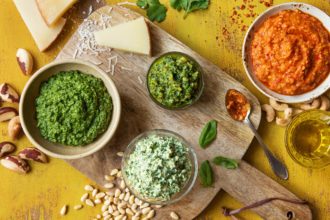Difference Between Olive Oil and Extra Virgin Olive Oil November 22, 2016
Think all oils are created equal? Think again. Continue reading to learn the difference between olive oil and extra virgin olive oil.
In an ideal world, there would be a one size fits all cooking oil – one that works for sauteing and frying, dipping and drizzling. Unfortunately, that’s not the case, which explains why the grocery store shelves are stocked with a slew of extra virgin olive oils, peanut oils, canola oils, vegetable oils, coconut oils, sesame oils…. the list goes on (and on and on and on).
Today, we’re tackling two of the classics: olive oil and extra virgin olive oil. Generally speaking, both are oils extracted from the fruit of olive trees. No surprise there. But what sets these kitchen staples apart is the process used to extract the oil and what, if anything, is added during the process. Although subtle, the differences are important. After all, this healthy fat has the potential to elevate your meals from “meh” to marvelous, but it can only work its wonders if used correctly.
Production Differences
Extra virgin olive oil (EVOO) is an unrefined, or unaltered, oil. It’s extracted from olives without the use of heat, just pressure. This technique is known as cold pressing and produces an oil with less than 1% oleic acid.
On the other hand, regular olive oil is a blend of olive oil (refined using mechanical, thermal, and/or chemical processes) plus a small amount (usually 10%) of extra virgin olive oil.
Flavor Differences
Regular olive oil has a mild and lighter taste than its extra virgin counterpart, which boasts a strong, faintly fruity, and distinctly olive flavor.

Cooking Differences
Whoa, not so fast. Before we get to the cooking part, it’s important to understand smoke points or, as our dietitian Rebecca explains, “specific temperatures when the oils start to smoke and burn. When this happens, the oil’s healthy nutrients degrade and unhealthy compounds form.”
If you’ve ever left oil in a pan over high heat a tad too long and discovered it’s no longer shimmering but rather billowing with smoke, you know what we’re talking about here.
Regular olive oil has a medium smoke point around 450 degrees Fahrenheit, which means you can use it for low-temperature cooking like sauteing. But when it comes to frying or deep-frying, stick to peanut oil.
EVOO has a lower smoke point around 320 degrees Fahrenheit. So although it can be used when cooking over low heat, we recommend reserving it for salad dressings, dips, and other cold dishes where its intense flavor can take center stage.
A little something “extra” about EVOO
It’ll help kick bad cholesterol to the curb while supplying a hefty dose of antioxidants known as polyphenols. These help increase HDL cholesterol (that’s the good kind) to decrease the risk of heart disease. But wait… it gets better. EVOO also nourishes your noggin with the help of hydroxytyrosol, a phytonutrient prized for its ability to protect the lining of blood vessels and oxygen supply to the brain.
So go ahead and drizzle, pour, and dip to your heart’s content.
READ MORE: Top 10 Foods For Heart Health
And the award for our favorite brand goes to…
…drum roll, please… Colavita! Drawing on four generations of olive oil expertise, Colavita’s top quality products hold a special place in our hearts (and in the HelloFresh boxes). Trust us on this one, we don’t mess around when it comes to olive oil.
Oil is not the only ingredient with the power to boost flavor. Discover five more ways to elevate your meals from drab to fab!











